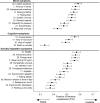Severity, course trajectory, and within-person variability of individual symptoms in patients with major depressive disorder
- PMID: 30447008
- PMCID: PMC6587785
- DOI: 10.1111/acps.12987
Severity, course trajectory, and within-person variability of individual symptoms in patients with major depressive disorder
Abstract
Background: Depression shows a large heterogeneity of symptoms between and within persons over time. However, most outcome studies have assessed depression as a single underlying latent construct, using the sum score on psychometric scales as an indicator for severity. This study assesses longitudinal symptom-specific trajectories and within-person variability of major depressive disorder over a 9-year period.
Methods: Data were derived from the Netherlands Study of Depression and Anxiety (NESDA). This study included 783 participants with a current major depressive disorder at baseline. The Inventory Depressive Symptomatology-Self-Report (IDS-SR) was used to analyze 28 depressive symptoms at up to six time points during the 9-year follow-up.
Results: The highest baseline severity scores were found for the items regarding energy and mood states. The core symptoms depressed mood and anhedonia had the most favorable course, whereas sleeping problems and (psycho-)somatic symptoms were more persistent over 9-year follow-up. Within-person variability was highest for symptoms related to energy and lowest for suicidal ideation.
Conclusions: The severity, course, and within-person variability differed markedly between depressive symptoms. Our findings strengthen the idea that employing a symptom-focused approach in both clinical care and research is of value.
Keywords: affective disorders; depression; psychopathology.
© 2018 The Authors. Acta Psychiatrica Scandinavica Published by John Wiley & Sons Ltd.
Figures



References
-
- Conradi H, Ormel J, De Jonge P. Symptom profiles of the DSM‐IV‐defined remission, recovery, relapse, and recurrence of depression: the role of the core symptoms. Depress Anxiety 2012;29:638–645. - PubMed
-
- Sakurai H, Uchida H, Abe T et al. Trajectories of individual symptoms in remitters versus non‐remitters with depression. J Affect Disord 2013;151:506–513. - PubMed
-
- Young MA, Watel LG, Lahmeyer HW, Eastman CI. The temporal onset of individual symptoms in winter depression: differentiating underlying mechanisms. J Affect Disord 1991;22:191. - PubMed
Publication types
MeSH terms
Grants and funding
LinkOut - more resources
Full Text Sources
Research Materials

